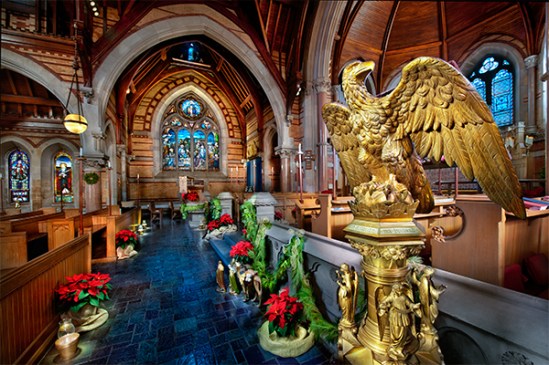
This is another image from the sanctuary at St Luke’s Church. It highlights The Eagle lectern which was made by J. & R. Lamb of New York. It is made of polished bronze and stands about six feet high from the pavement to the Eagle’s beak. It rests on a heavy bluish marble cross at its feet, laid horizontally on the pavement. The bronze shaft rises from the middle of the cross and is rectangular with chamfered angles. At the summit of the columns, the shaft swells into a large knop with four faces on which appear the four emblems of the Evangelists in raised medallions. The cylindrical shaft above the knop is encircled by four angels, each above his own medallion, and holding scrolls bearing the names of the Evangelists. The eagle stands about 20 inches in height and 2 1/2 feet across the back and wings. On the extended wings of the eagle is the book rest to hold the Bible. This lectern is the second largest in the country, the only larger one being in Trinity Episcopal Church, New York.
the following was supplied by the church historian concerning who actually donated this amazing piece to the church.
The inscription on the lectern is “In memoriam my husband Wm. Coleman who died May 24, 1861.”
Many in Lebanon County know the Coleman family as the first family of Lebanon. Owners of the Cornwall Iron Mine, the largest iron ore deposit east of Minnesota and the nation’s primary source of iron in the early 19th century, since 1798, they also build iron furnaces in Cornwall, Colebrook, Lebanon, and other locations. William Coleman was one of the principle heirs in the first half of the 19th century. He married a Southern belle, Sue Ellen Habersham from Savannah, before the Civil War. They had 2 children before he died at a young age in 1861, Robert Habersham and Anne. Sue Ellen remained a dominant force at St. Luke’s and in Lebanon County for 30 years after William’s death (http://www.lebcounty.org/Womens_Commission/Documents/Womens_History/Coleman_Women_LCCWrev.pdf). William was the driving force behind the construction of Old St. Luke’s in 1862-3.
When Robert came of age, he and his sister (obviously with the encouragement of their mother) built the current church in 1879-1880 (http://en.wikipedia.org/wiki/Robert_Habersham_Coleman). The entire church is their memorial, although Anne also donated the angel mosaic on the south wall. The lectern was given in honor of William Coleman by his widow when the church was built.It apparently was modeled after the lectern in the previous building of St. Bartholomew’s Church in New York City, Mrs. Coleman’s church when she was at her New York residence, although eagle lecterns are common in Anglican and Episcopal churches). If you don’t know the tragic story of Robert and his first wife Lilly and his fall from eminence in the Panic of 1893, there are several books about it that make interesting reading





























